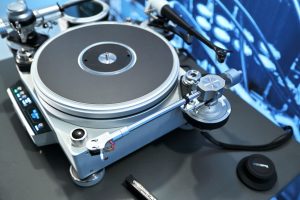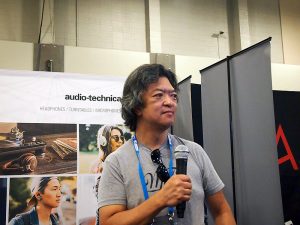Best New Product in Show
DPA has come out with something new, a vocal microphone using their existing 4000-series capsules. You can order it as an omni, cardioid, or hypercardioid, and you can order it as a a handheld mike or as a head that fits onto a number of standard wireless systems. These are very clean capsules combined with a well-designed blast filter for vocals and this "d:facto" line looks worth checking out.
Worst New Product in Show
Urban Denoiser Player is a compressor application for your Android so that if your music isn't already made too loud in mastering you can make it still louder so as to drown out external street noise. It is described as "an alternative to active noise reduction."
Best and Worst Demo in Show
Lipinski Sound did a demo with 8-channel playback of a recording of a Chopin piece for fortepiano and vocal, compared with a live performance of the same piece with the same performers and a similar piano. And I have to give this "best demo in show" because it was the best conducted live vs. recorded demo I have heard. But I also have to give it "worst demo in show" because like all of these demos there was a obvious and complete difference between the two.
The live recording was made in Paris and listening to it, it sounded very large... even with the multichannel system although there was a sense of space the piano seemed enormous and stretched across the soundfield. The overall sound was kind of harsh and strained, with a sort of tonsil sound on the vocals that didn't sound real at all. And then we went to the live performance and the improvement was night and day.
Now, admittedly Andrew Lipinski said that this was "for entertainment only" and was not intended to be a scientific demonstration. And the recording was clearly made with the intention of playing back in a smaller room than the one being used for the demo. But I know these are great speakers, I know they sound good, but in a demo like this they are being asked to live up to an unbearably high standard.
So, I tell all vendors... please don't do a demo like this, because even if your speakers are as wonderful and accurate as Lipinski's, it will never show your system in a good light to compare it with something so perfect. You cannot live up to the live comparison. So, this demo gets both best and worst awards. I have never done this before but it's how it seems to have worked out.
Best Sound in Show
Over the years I have heard lots of demonstrations of "3D audio through two speakers" and they have invariably never really worked well. A company from the UK, Opsodis Limited, actually seems to have a system that mostly works... objects are imaged in three-space very well including height and some amount of positioning in the rear. The system is far from perfect but it is far better than any of the previous attempts I have heard. I can't call this the best new product yet but it has great promise and I think it deserves a best sound in show award if only for being the most dramatic.
Worst Sound in Show
A speaker manufacturer whom I won't name was showing a video of the assembly
line and the processes involved in constructing their speakers. The video itself was well-made and perfectly timed to the music. But the music backing it was Confutatus Maledictus from Mozart's Requiem, in which the choir is singing about the damned being cast away into the searing flames. Although the reproduction quality was very good, the sound itself was not conducive to selling speakers.
Loudest Sound in Show
It just happened that the show took place on VE day, and not just any VE day but the 70th anniversary of the defeat of Germany in the war. There were extensive celebrations which happened to be taking place in the square right outside our hotel.
Best Paper in Show
Estimation of the radiation pattern of a violin during the performance using plenacoustic methods by Antonio Canclini and others from the Politecnico di Milano was one of those ingenious things that make you think why you didn't think of that first. The radiation pattern of stringed instruments is quite uneven, with some tones coming from the body and others coming from the strings and still more from the f-holes, so what the instrument sounds like varies a lot based on direction (making close-miking difficult). These folks took a fixed array of microphones in a dead room, and moved the violin around while playing it. Gyros on the violin body allowed the position of the violin to be constantly tracked while the spectrum of a single note was recorded. As the violin player moved around physically, a complete plot of spectrum versus angle could be plotted. The method is ingenious, the results useful. Preprint 9248.
Worst Paper in Show
Design and Evaluation of Accelerometer based Motional Feedback isn't a bad paper at all, it's just about fifty years too late. Henrik Schneider and others from the Technical University of Denmark basically rediscover the use of accelerometer feedback to linearize subwoofer drivers that came out of Philips in the 1960s, as used by Velodyne in commercial products since the mid-1980s. It's a good design, it's a great idea, and their control theory analysis of the system is excellent and agrees well with that from the original work in the sixties which the authors seem to have been unaware of. Preprint 9293.
Best Free Stuff in Show
Ablo was giving away some handy notepads with graph paper ruling and a ruler on the side... but it was metric! Very handy for anyone working on metric projects and something you can't find even for ready money here in the US.






































